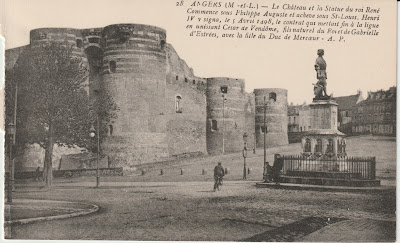The Castle of Angers and the statue of René of Anjou
A. Papeghin, imp.-édit., of Tours printed this vintage black & white card featuring the Castle of Angers, located in the Loire Valley of France. At the right is a statue of René of Anjou who was born here and is known as Good King René. This card was one in a booklet set and has been torn out along the perforated left side. The information blurb is printed on the front of the card at the upper right and contains the number 28. The blurb contents translated into English: “The Castle and the statue of King René began under Philippe Auguste and was completed under Louis. Henry IV signed the contract thee on April 5, 1498, which ended the League by uniting Cesar de Vendôme, the natural son of the King and Gabrielle d’Estrees, with the Duke of Mercoeur. A.P.”
It looks more like a fortress than a castle because it was a fortress in the beginning due to its strategic defensive location. Like some other castles or fortresses it was built on a site previously held by the Romans. The structure shown on the card is the result of permission by the Bishop of Angers to the Counts of Anjou to build a castle here in the 9th century. There are dozens of castles that were built about this time to protect Anjou from the Normans. There have been many additions and renovations to the original building. It has been listed as a historical monument since 1875. Today it is owned by the City of Angers, is open to the public and has been converted into a museum. The museum is home to the oldest and largest collection of medieval tapestries in the world, including the priceless Apocalypse Tapestry.
René of Anjou was born in 1409 and died at age 71 in 1480. He was Duke of Anjou and Count of Provence from 1434 to his death in 1480. He also reigned from 1435 to 1442 as the King of Naples. He was married twice and had 10 legitimate children and 3 illegitimate children. As a patron of the arts, both paintings and written works, he commissioned translations and re-translations of classical works into French prose. He also kept a theater troupe in his court.
For additional information, see:
https://en.wikipedia.org/wiki/Ch%C3%A2teau_d%27Angers
https://en.wikipedia.org/wiki/Ren%C3%A9_of_Anjou
https://en.wikipedia.org/wiki/Gabrielle_d%27Estr%C3%A9es

No comments:
Post a Comment